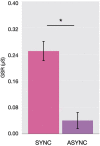The toolish hand illusion: embodiment of a tool based on similarity with the hand
- PMID: 33479395
- PMCID: PMC7820319
- DOI: 10.1038/s41598-021-81706-6
The toolish hand illusion: embodiment of a tool based on similarity with the hand
Abstract
A tool can function as a body part yet not feel like one: Putting down a fork after dinner does not feel like losing a hand. However, studies show fake body-parts are embodied and experienced as parts of oneself. Typically, embodiment illusions have only been reported when the fake body-part visually resembles the real one. Here we reveal that participants can experience an illusion that a mechanical grabber, which looks scarcely like a hand, is part of their body. We found changes in three signatures of embodiment: the real hand's perceived location, the feeling that the grabber belonged to the body, and autonomic responses to visible threats to the grabber. These findings show that artificial objects can become embodied even though they bear little visual resemblance to the hand.
Conflict of interest statement
The authors declare no competing interests.
Figures





References
-
- Strawson, P. F. Individuals : an essay in descriptive metaphysics. (Methuen, 1959).
-
- Martin MGF. Sight and Touch. Contents Exp. 1992 doi: 10.1017/CBO9780511554582.010. - DOI
Publication types
Grants and funding
- 44931-2014/Canadian Network for Research and Innovation in Machining Technology, Natural Sciences and Engineering Research Council of Canada (NSERC Canadian Network for Research and Innovation in Machining Technology)
- 754490/EC | Horizon 2020 Framework Programme (EU Framework Programme for Research and Innovation H2020)
- 249877-2006-RGPIN/Canadian Network for Research and Innovation in Machining Technology, Natural Sciences and Engineering Research Council of Canada (NSERC Canadian Network for Research and Innovation in Machining Technology)
- ANR-11-LABX-0042/Association Nationale de la Recherche et de la Technologie (National Association for Research and Technology)
- CeSaMe ANR-10-IBHU-0003/Association Nationale de la Recherche et de la Technologie (National Association for Research and Technology)
LinkOut - more resources
Full Text Sources
Other Literature Sources

